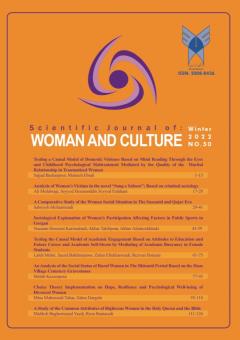An Analysis of the Social Status of Rural Women in The Ilkhanid Period Based on the Haas Village Cemetery Gravestones
Subject Areas : History & Archeology
1 - Islamic Art University in Tabriz, Department of Archaeology, Tabriz, Iran.
Keywords: rural women, Gravestone inscriptions, Ikhanid period, Has village,
Abstract :
The object of the present research was the analysis of the social status of rural women in the Ikhanid period based on the Haas village cemetery gravestones. 200 gravestones were intact which by non-probabilistic sampling procedure 20 gravestones that contained the maximum data on women professions were selected and studied. Concerning the object, the research was a qualitative with descriptive-analytical method. To obtain the data, in the initial stage, based on field studies, the necessary documentation such as photography, redesign and interpretation of inscriptions and motifs were proceeded. After presenting the descriptions and library information, the data were reviewed by analytical method. The results indicated that, with the arrival of the Mongols in Iran, the situation of women changed and they were able to play a freer role alongside men in the various society affairs. Historical sources as well as artistic evidence showed the prominent position of court women (especially the Ladies) in political and social relations, and no data were available about rural women of the period. Meanwhile, on the tombstones of Haas Cemetery, rural men and women were depicted who, during their lifetime, each held a job in a social position and had acquired a social status commensurate with their profession. This was recognizable by the type and dimensions of the tombstones, artistic techniques, inscriptions, motifs, as well as objects on the tombstone. Men in professions such as farmer, rancher, hunter, musician and servant, and women in “Varni” weaving (durries weaving), who played a prominent role in the livelihood of the society of that period, enjoyed a similar position with men.
Abdi, S., Basam, S. J. A., & Mirzayi, A. (2016). Design and mutif analysis in contemporary rural carpets in Ahar city. Goljam, 11(27), 77-97. URL: https://goljaam.icsa.ir/article-1-206-fa.html
Ajhand, Y. (2010). Interaction of Iranian, Islamic and Turkish cultures in Shiraz (8th and 9th centuries). Iranian History, 6(1), 15-1. [Persian] URL: https://www.sid.ir/fa/journal/ViewPaper.aspx?ID=135686.
Bayani, Sh. (2010). Women in the Monghol Period. Teharn: Tehran University publication. [Persian] URL: https://www.gisoom.com/book/1611028
Basam, S. J. A., Zarye Zahra, S. A. A., & Farjou, M. H. (2007). Dream of Heaven: The Art of Iranian Carpet Weaving, Tehran: For 14. [Persian] URL: https://www.gisoom.com/book/1317493//
Dousti, H. (1995). History and geography of Arasbaran. Tehran: Ahrar. [Persian] URL: https://www.gisoom.com/book/168928
Daneshgar, A. (1998). Comprehensive culture of memorial carpet "Encyclopedia of Iran". Tehran: Asadi Memorial. [Persian] URL: http://fipak.areeo.ac.ir/site/catalogue/18454148
Seyed Sadr, S. A. Gh. (2019). Encyclopedia of handicrafts and related letters. Tehran: Simaye Danesh. [Persian] URL: https://www.gisoom.com/book/11109013
Farokhi, Y. (2015). Research on women (Ermuk) in the formation of the Mongol army. Social History Research, 4(1), 129-107. [Persian] URL: https://civilica.com/doc/795839/
Jamali, B., Hasani, M, M., & Behrouzi, M. (2021). The social status of women in the Sassanid period (based on seals and the effect of seals). Islamic Art Journal, 39(1), 70-56. [Persian] URL: http://www.sysislamicartjournal.ir/article_120671.html
Karoubi, A., & Fayaz Anoush, A. (2017). Historical study of women's clothing in the Ilkhanate period (736- 654 AH). Journal of Post-Islamic Iranian History, 7(2), 161 189. [Persian] URL: https://www.sid.ir/fa/journal/ViewPaper.aspx?id=321931
Kazempour, M., Omrani, B., & Rezalou, R. (2013). A new approach to the large stone tombs of East Azerbaijan based on the findings of the Zardkhaneh area. Archaeological Study, 4(1), 74-55. [Persian] URL: https://www.sid.ir/fa/journal/ViewPaper.aspx?ID=265967
Kazempour, M., & Shokrpour, Sh. (2021). A symbolic analysis of the Islamic Period Gravestones in the Ahar Museum. International Journal of Historical Archaeology, 25(1), 1065-1086. URL: https://link.springer.com/article/10.1007/s10761-021-00588-6
Karoubi, A., & Fayaz Anoush, A, H. (2017). Historical study of women's clothing in the Ilkhanate period (736-654 AH). Iranian of Islamic Period History, 13(1), 161-183. [Persian] URL: https://www.sid.ir/fa/journal/ViewPaper.aspx?id=321931
Malekzadeh, E. (2009). The political, social and cultural situation of women in the Mongol and patriarchal periods. Maskouyeh, 4(2), 206-167. [Persian] URL: https://www.sid.ir/fa/Journal/ViewPaper.aspx?ID=214027
Polo, M. (1257). Travelogue. Translated by Habib olah Sahihi. (1972). Tehran: Book Translation and Publishing Company Publications. [Persian] URL: https://taaghche.com/book/18111
Mesbah Ardekani, N. M., & Dadvar, A. (2009). The mufti of the female on Iranian seals from the pre-linear period to the end of the Sassanid period. Women in Development and Politics Journal, 4(1), 161-184. [Persian] URL: https://www.sid.ir/fa/journal/ViewPaper.aspx?id=85159
Mohammadi, S. (2016). Investigating the structure of design and role from the aesthetic point of view of Dorney Ardabil. National Conference of Handmade Carpets, South Khorasan Birjand University. [Persian] URL: https://www.sid.ir/fa/seminar/ViewPaper.aspx?ID=55257
Nourolahi, A., Talayi, H., & Firouzmandi, B. (2016). The position of women in the Iron Age based on archeological studies among the nomads of the western Central Zagros. Woman in Culture and Art, 1(2), 107-120. [Persian] URL: https://www.sid.ir/fa/journal/ViewPaper.aspx?id=279491
Sharad, E. (2015) Women of the Great Mongolian Shahnameh (Analysis of the role and position of women in the Great Mongolian Shahnameh with a Baztab approach). Women in Culture and Art, 3(1), 391-408. [Persian] URL: https://journal.ut.ac.ir/article_54518.html
Shirkhani, M. R., Ahikhteh, F., & Ahikhteh, T. (2017). A study of the social status of women among the literary texts of ancient Iran and the pre-Islamic Arabs. Exploration of Comparative Literature, 6(22), 89-114. [Persian] URL: https://www.sid.ir/fa/journal/ViewPaper.aspx?ID=281121
Talebi, Y. (2010). Reflection of the position of women in patriarchal pottery motifs. Fine Art, 40(1), 63-70. [Persian] URL: https://www.sid.ir/fa/Journal/ViewPaper.aspx?id=113261
Yasini, S. R. (2015). A comparative study of the image of women in Persian literature and Iranian paintings. Women Studies, 10(1), 139-162. [Persian] URL: https://www.sid.ir/fa/Journal/ViewPaper.aspx?id=234027
_||_

